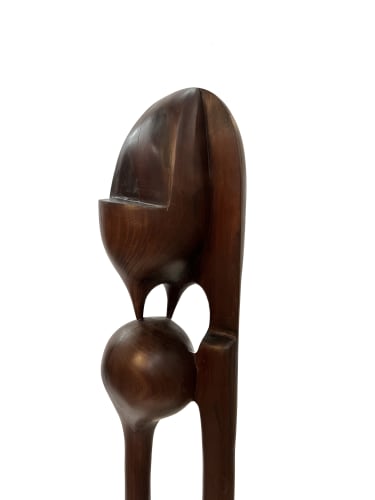The sculptor is often compared to another well-known Cuban artist, Wilfred Lam, as the œuvre of the two artists features a similar preoccupation with Afro-Cuban culture. The art of Cárdenas embodies this double identity – that of a Cuban of African descent.
His early pieces were often figurative and he was especially interested in depicting the female form. Throughout his career, his organic sculptures evoked closeness and intimacy in human relations, depicting not only physical proximity, but also the variety of emotions and interactions found within any relationship.
The totems were polished and refined, generally made from ebony or marble, giving off the impression that they developed naturally. They are particularly noted for their sensual and intellectual provocation.
The renowned Cuban sculptor Agustin Cárdenas, descendant of Senegalese and Congolese slaves, was born in Matanzas, Cuba, in 1927. Cárdenas is considered one of the greatest Cuban sculptors in addition to being one of the last artists to join the Surrealist movement. His artistic production can be divided into roughly three periods. From 1951 to 1964, he created works that can be classified as totem morphology.
From 1965 to 1982, he focused on the use of marble and other hard solids such as granite, spending time in Carrara, the Italian region famed for its beautiful white and blue-grey marble. After 1983, he added bronze works to his œuvre, By this time, many of the Surrealist values had been accepted and even assimilated by society. The movement thus became increasingly exclusive and sought to appeal only to those who were profoundly interested in its ideals. André Breton had already written in the Second Manifesto of Surrealism of his desire to bring about the “profound occultation of Surrealism.” He wished to transform the movement into a secret, closed group and submit new Surrealists to a kind of initiation. Agustin Cárdenas was thus “knighted” a Surrealist by Breton and invited to exhibit his works at a group exhibition at L’Étoile Scellé, a Surrealist art gallery. In 1959, the sculptor was the subject of a solo exhibition at the Galerie de la Cour d’Ingres, where André Breton presented him. Breton wrote of Cárdenas that his hand, the symbol of artistic production, was “as nimble as a dragonfly”.casting the majority in Pietrasanta in northern Tuscany.
The totems he created during his stay in France explore his African heritage more explicitly, but by the end of his career Cárdenas had once again turned to Abstract forms. From the 1960’s, he was commissioned to create monumental sculptures in diverse areas ranging from Japan, Austria, Israel and the Canary Islands. Cárdenas is generally considered the precursor of abstract art in sculpture, with his revolutionary large-scale sculptures created from minerals native to the site. He was thus one of the earliest creators of “site-specific” pieces, an extension of his organic movement.
Agustin Cárdenas studied at the Beaux-Arts Academy of San Alejandro in Havana, Cuba from 1943 to 1949. His teacher and mentor was Juan José Sicre, one of the greatest Cuban sculptors, known as the “Master of Masters.” Sicre had studied in Paris under Antoine Bourdelle and soon recognized the vigour and talent of his young protégé. He introduced Cárdenas to avant-garde art, showing his students works by Jean Arp, Constantine Brancusi and Henry Moore once official classes had ended. It was thus early in his career that Cárdenas absorbed the pared-down, non-objective, modernist ideals of the avant-garde and his sculptures of the time evoke the work of Picasso in the late 1920’s.
In 1949, the promising student left the Academy before obtaining his diploma. It was also in this year that he won the Segundo Premio at the sixth Salón Nacional de Pintura y Escultura, Salones del Capitolio Nacional in Havana. From 1951 to 1955, he was a member of the Asicuacui de Grabadores de Cuba and from 1953 to 1955, of the creative group Los Once, which opposed official and academic methods of teaching art. 1955 was a significant year for the budding sculptor, as he presented his first individual exhibition at the Palacio de Bellas Artes in Cuba and was awarded the Silver Medal XXXVII at the Salón de Bellas Artes, Círculo de Bellas Artes. In the same year, he moved to Paris on a scholarship in the same year and settled in Montparnasse. He soon made the acquaintance of the French Surrealist author and poet, André Breton, who inducted him into the movement.




